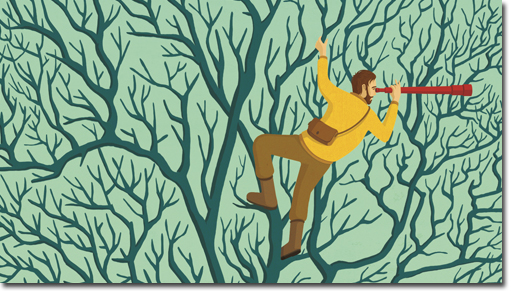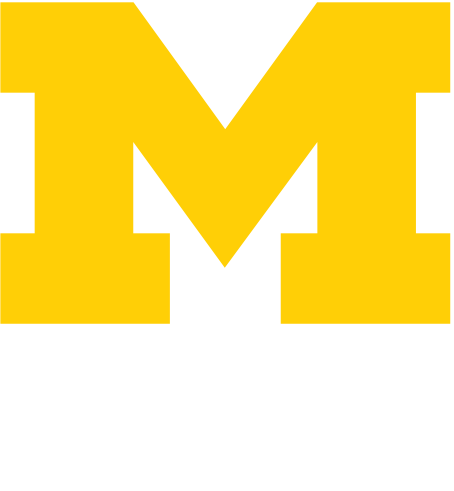Trees of Life

How a fusion of past and present, personal and professional, led one scientist to find his voice.
My life is at a flex point. I am finishing my PhD in water quality, recently became a new father, and am deciding what to do next. If I were on the classic academic path, my next move would be to get a postdoc in a related field of study, publish extensively, and scramble like hell to find positions that might (eventually) get me on the tenure track. These moves seem so straightforward, simple, logical. It's almost like looking at a classic tree of life—full of rigid, extending branches that move linearly and inexorably toward a set endpoint.
Yet when I speak with people who seem the most satisfied with their lives and career choices, this simplified path is the one least taken. They have traversed winding roads—full of unexpected turns, struggles, and joyous coincidences. When I visualize their lives, I conceive of a tree with graceful looping branches—past experiences bringing understanding and nuance, rather than a rigid path from A to B. It's not unlike the theory of endosymbiosis: one organism becoming encapsulated and a part of another, bringing increased complexity and functionality to the new chimeric being.
I believe that the search for a meaningful life is too individual to make broadly applicable sweeping statements. However, this idea of incorporating the past—the melding of these moments of joy, struggle, and clarity—has been invaluable for thinking about my career. My own journey into public health can only be explained by making my health public.
"You have fibromyalgia." These words, a diagnosis during my senior year of college, scared but relieved me. I had spent the past 13 months afflicted by mysterious pain that started in my hands and had quickly spread throughout my body. Now I had an answer, but it wasn't one that I wanted. Fibromyalgia? A lifelong pain condition affecting both body and mind that has no straightforward treatment?
"Finding my writing voice helped me become more honest about myself."
Simultaneously, though, I was relieved. In those 13 months, I had slogged through the medical system, received multiple unhelpful diagnoses, gone to a chiropractor and physical therapy, changed my diet, and tried many other approaches. My parents generously supported my ballooning health care costs, and my girlfriend tried to buoy my mood. Nothing really helped. But now, with a real diagnosis, perhaps there was a chance for useful treatment. And as I learned, there was.
Through trial and error, I started developing a toolbox of management approaches. I practiced yoga, ate healthier, worked on sleep hygiene, and occasionally used medication—all of which helped manage my pain. My health slowly improved. Getting this under control represented a moment of irreversible fusion—an encapsulated experience that would shape everything to come.
I finished my BS in biology in 2009 and started working at NSF International (NSFI), testing water filters and their contaminant removal capacities. During this time, I continued modulating my lifestyle: I exercised daily, ate carefully, and, with my wife and friends, started a communal vegetable garden and raised chickens. I now understood how health could be bolstered by the interplay between personal change and external support systems, including societal ones. But how could I synthesize these ideas into a fulfilling career?
This thinking bled into my approach at NSFI, where I realized how the burden of water pollution falls unequally on disadvantaged people and communities. After the 2011 Fukushima Daiichi nuclear disaster, my lab tested whether existing technology could remove iodine from contaminated water in Japan. These experiences looped into my psyche and cemented my career focus: doing actionable research that is responsive to people's needs and helps build tools for improving public health. I started my PhD in 2012, studying drinking water contamination with Helicobacter pylori—the primary cause of stomach cancer.
For my dissertation, I embarked on an interdisciplinary project to elucidate and mitigate effects of waterborne H. pylori in Lima, Peru. While working on this project, I recognized the importance of tailoring research and language to communicate meaningfully with various audiences. To practice, I took a class on science blogging, and was delighted to learn that I loved writing.
Finding my writing voice helped me become more honest about myself. I became more open about my health issues, and was thrilled by the empathetic reception and better relationships that followed. I realized how good communication builds common understanding for meeting shared challenges. This, and the support of fellow science writers, inspired me to start submitting pieces to various outlets—a few of which were published by Science magazine. Some of my blog posts got noticed by the media, and I did radio interviews—an exciting new way to communicate. Combining my interests in communication and health, I pursued yoga teacher training to help others regain control over their lives, as I had.
This unplanned branching out wasn't on the traditional academic path, but it gave me a hands-on application for my interest in health. In a sort of intellectual endosymbiosis, my fragmented interests were melding together into a new worldview.
During this time, I used my own experiences as a springboard to start learning about chronic pain, and realized that I was one of 100 million Americans with chronic pain. My previous struggles with the medical system were not unique, but commonplace. I met with Dr. Daniel Clauw at the Chronic Pain and Fatigue Research Center at the University of Michigan Medical School. We discussed the lack of support for less invasive chronic pain treatments like diet, exercise, and cognitive behavioral therapy. Soon after, we conducted a study, showing that patients with chronic pain who use medical cannabis report reduced medication use and side effects, as well as better quality of life. This study changed my future research path. I realized that I had found a research area that allowed me to exercise both my personal and scientific voice. I had come full circle.
As Faulkner wrote, "The past is never dead. It isn't even past." My path was not unique. As with so many others who found their way to public health, it was about fusion of experience, with formative events becoming inextricably interwoven with the present, changing the direction of the future. May we all remember that as we traverse the paths to come.
Kevin Boehnke will finish his PhD in environmental health sciences at U-M SPH in 2017. He is fascinated by the intersection between science, education, and policy, especially as it relates to chronic pain, water, and food.


